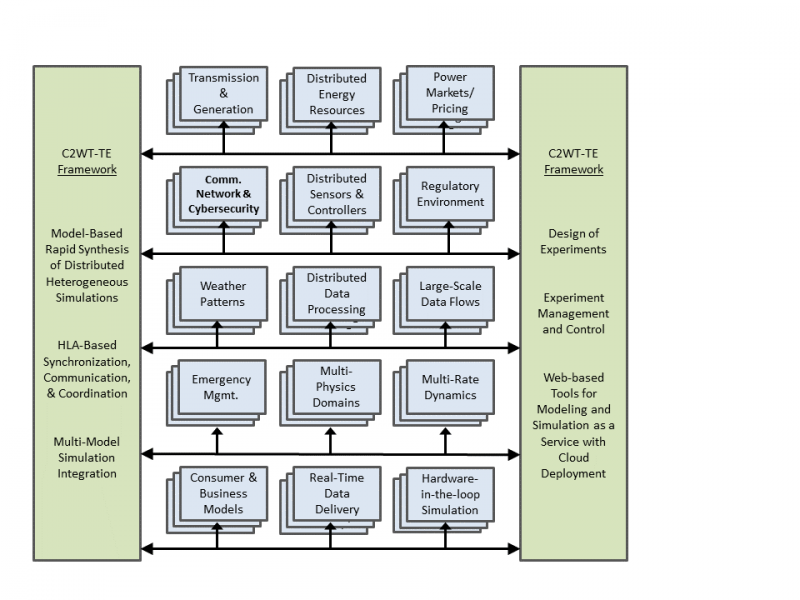 Home Page Content
Home Page Content
Evaluation of smart grid in the presence of dynamic market-based pricing and complex network of small and large producers, consumers, and distributers is very difficult task. Not only it involves multiple, interacting, heterogeneous cyber-physical domains, it also requires tight integration of power markets, dynamic pricing and transactions, price-sensitive consumer behavior, who may also be producers of power. This introduces a huge problem of maintaining stability of the power grid. Moreover, the evolving business models including human factors need to be a key part of the evaluation due to continual changes in regulations and as they directly affect the demand-response in the grid. Furthermore, as sensors and computations are becoming more distributed on edge devices and often employ normal communication channels, cyber security of the critical power grid infrastructure has become ever more important to prevent cyber intrusions and attacks. Current research has largely focused on one or a few of these challenges and the simulation tools developed cater to these individual tasks, such as network simulators, power simulators, or human organization and policy simulators. However, to attain a deeper understanding of the operations and their effects on the stability of the grid as well as to optimize resources both from consumers and generators perspective, a rather encompassing platform is needed to facilitate end-to-end evaluation of all of these aspects. This group is about creating, populating, curating, and maintaining an open platform that provides a comprehensive framework for integrated transactive energy simulations of smart grids and is readily customizable and extensible for various smart-grid related simulation tools as well as flexible for evaluating custom use-cases generated by various users.
Power grids today are going through a major transformations with the increased use of renewable energy generation technologies, and market-based transactive exchanges between energy producers and consumers. Modern technology continues to evolve power grid systems for increasing their efficiency, reliability, and security. Transactive Energy Systems (TES) employ economic and control mechanisms to dynamically balance the demand and supply across the full electrical grid. These systems use value as a fundamental operational parameter to ensure most economical distribution and utilization of power. This, in turn, has allowed the advent of a wave of small-scale producers, such as those using household rooftop solar panels, and local distributors. However, by allowing a large numbers of participants in power generation and consumption, the power grid becomes susceptible to large market-induced variations in demand and supplies, which poses an immense problem of maintaining stability of the power grid. Moreover, the continual changes in the regulatory framework and regional variation in policies create a major hurdle for implementing efficient business models. Furthermore, there is a constant push toward increasing communication and control efficiency in the power grid by distributing sensors and computations on edge devices closer to the loads and distributors. These devices often use normal communication channels, such as the public Internet. This opens a large set of potential vulnerabilities in the cyber infrastructure of the power grid and makes it susceptible to cyber intrusions and attacks. With these evolving diverse sets of directions, the implementation of TES is highly complex.
Modeling and simulation of smart grids with TES is difficult due to the large number of heterogeneous components. The power grid consists of several physical componen ts (such as power generation equipment, transmission and distribution lines, sub-stations, transformers, edge devices, etc.), a number of computational components (such as sensors, monitors, meters, controllers, analyzers, etc.), and several human interaction components (such as consumers, distributors, small-scale generators, large utility organizations, business models, and regulatory policies). Simulation of these heterogeneous components pose a number of modeling and simulation challenges spanning the power network planning, communication network planning, business models and operational strategy planning, transmission and distribution planning, vulnerability analysis, and cyber security planning. Also, maintaining coherence between the transactional and the physical states of the system poses a significant challenge.
Enabling TES for the next-generation power grid requires efficient integration of digital information, communication networks, cyber security, distributed monitoring and control, real-time data analytics, dynamic power pricing, and failover and adaptive implementations. These aspects go beyond traditional communication network modeling, human organization modeling, and power engineering - rather the effective evaluation of smart grids require all of these systems integrated. Additionally, each of these degrees of freedom is modeled based on algorithms and assumptions for which there are many competing alternatives. Therefore, a comprehensive and open platform is necessary that allows rapid integration of a heterogeneous set of simulation tools and facilitates virtual prototyping and large-scale experimentation of transactive smart grid systems.
C2WT-TE or Command and Control Wind Tunnel for Transactive Energy is an open platform that enables model-based integration of diverse simulation tools for rapid synthesis of distributed simulation experiments. The platform is open such that it is (a) customizable to support different configurations of simulation tools, (b) extensible to support the platform itself with addition of other simulation tools, and (c) configurable to run simulations that are highly distributed across different locations.
Figure below show the notional architecture of C2WT-TE and details various concerns that need to be address in a single coherrent platform in an integrated manner.

Coming soon:
- NIST Transactive-Energy Challenge Co-Simulation Group details
- Scenario documents
- Web-based C2WT-TE Co-Simulation Platform
- C2WT-TE end-to-end TE co-simulation examples (all via WebGME front-end, i.e. simply through a Chrome Internet Browser)
- Interface definitions for adding your simulation tool as an HLA-Federate to the C2WT-TE Platform
Note: If you wish to gain access to this group, please send an e-mail to Himanshu Neema at {himanshu at isis dot vanderbilt dot edu} and indicate
- your full name,
- affiliation,
- oragnization provided e-mail address,
- contact phone number, and
- a brief statement how you would benefit from participation in this group.

